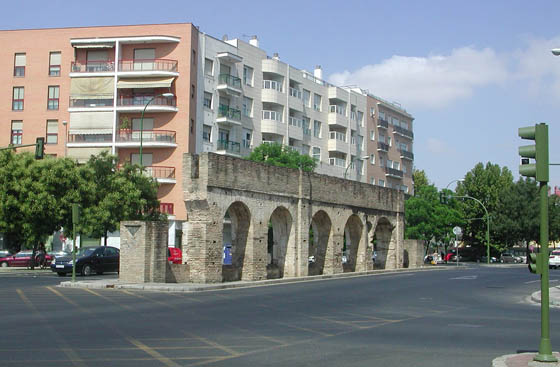One of the many things I love about Sevilla is the blending of the old and the new. I already shared in July my first impressions of (and visit to) the Metropol Parasol and the Roman ruins that were discovered beneath. But, I haven’t mentioned my first sighting, when we were here in January, of prominent remnants of a more-than-2,000-year-old Roman aqueduct.
 |
| RUNNING DOWN THE CENTER OF THE MODERN STREET. THE MOSAIC IS A LATER ADDITION. |
Portions of the aqueduct have been preserved and, as needed, reinforced right in the center of a busy street that runs through one of the more contemporary parts of the city near the neighborhood of Nervión. The remains are on the same street as (and just one block away from) the vacation apartment we rented during the winter.
 |
| A STUDY IN CONTRASTS. |
The aqueduct is known as “los caños de Carmona” (the pipes of Carmona) and runs along the modern Calle de Luis Montoto, originally a Roman road known as the East street and later as the Calzada (sidewalk) of the Pipes of Carmona. (Carmona is a town about a half hour east of Sevilla, famous for its Roman ruins.) The old Roman road connected Sevilla’s Carmona Gate with the city of Córdoba about 142 km (88 miles) away.
 |
| AT THE NEXT CORNER, ANOTHER SECTION, WITH CONTEMPORARY REINFORCEMENT. |
The aqueduct was built between 68 and 65 BC — when Julius Caesar conquered Spain. Most of the water channel was buried for it’s 17.5 km (11 mile) length. Amazingly, the aqueduct was still in use in the 19th century until it was mostly demolished in 1912.
 |
| OF COURSE, WITH THE ADDITION OF A VIRGIN IN CHRISTIAN TIMES. |

I love to see those old ruins saved, and then see how they look set among modern architecture.
Very cool, the old and new.
I think that is what I love so much about Europe, it's past. And the fact that they are keen to keep as much of their past in their future. It's a beautiful place you live now.
Scott
http://www.travelwithscott.com
Hello Mitch:
We agree with you that there is a great bravura about these bold juxtapositions of contemporary and ancient. They draw the eye and add such interest to what otherwise might be a street like many others across Europe.
The aqueduct remains do look to have been very carefully and sensitively restored and preserved for future generations to enjoy. Perfect!
Bob:
Definitely very cool. One of these days, we'll head back over to the Antiquarium (5 minutes from home) to see in detail the 2,000-year-old treasures they found under the Plaza de la Encarnación. It's amazing.
Scott:
I hope I never take all this for granted!
J&L:
And to think we called our house in San Diego old. It was built in 1924!
It would make an interesting water feature, water falling from both sides…
Peter:
First I laughed. Then I thought, "Well, that would be really beautiful." Maybe we could design a replica (scale model, I suppose) for our living room.
The juxtaposition of the old and the new is visible everyday in all areas of the UK. I feel privileged to live in a country with such a rich heritage. This aqueduct is amazing. Makes you think of the guys who built it so long ago.
the cuby poet:
There is nothing like this in any city of the USA. The oldest structures I think I ever saw there were the Anasazi cliff dwellings at Mesa Verde National Park — in wide-open country in Colorado. The cliff dwellings are stunning to see. But they were built more than 600 years AFTER this aqueduct.
Wow, this is amazing! Love the contrast of old and new and how the two live happily side by side. Really adds character to a city.
There's always room for a virgin or two!
m.
Your photos always amaze me!
Jeff:
The contrasts can be seen everywhere in this city.
Mark:
It's a good thing. There are a lot of them here.
kisatrtle:
Thanks. (But it's probably the subject matter more than the skills of the photographer!)
good places to live incorporate the old and the new…. not overpowering either!
And here (USA) they demolish 30 year old buildings. Go figure.
John:
I agree!
FDeF:
Fortunately, they don't do that everywhere!
Smart 'city planners'! These look great and not overwhelming at all. Keeps us in tune with the past and where we came from. Great photos Mitch!
Jim:
Thanks. I'm really glad you're enjoying this.